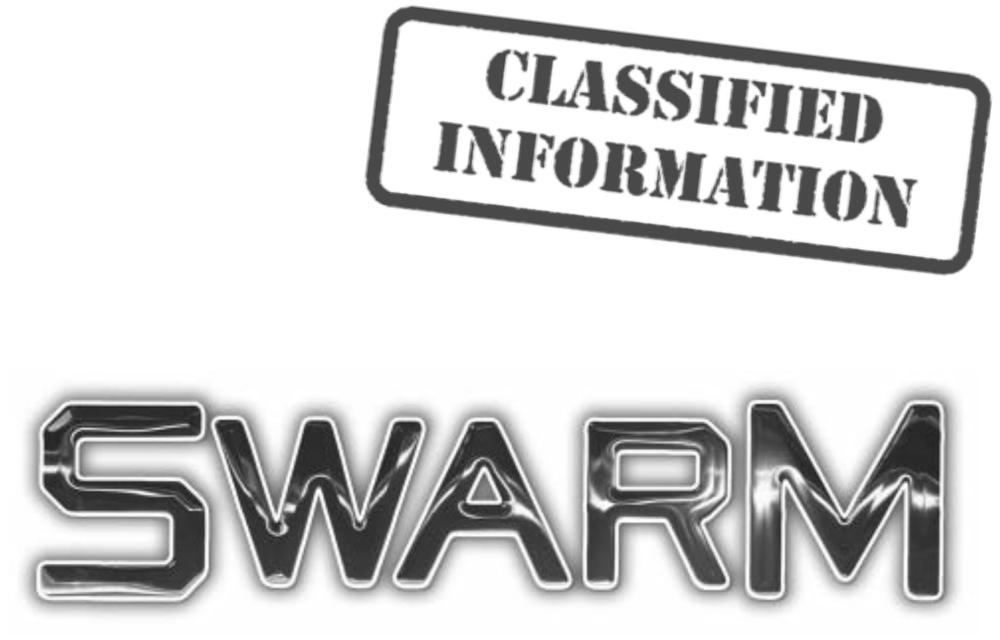Project Venom
Authors: Simon Cheshire





SPECIALISTS IN NANOTECHNOLOGY AMD BIOMIMICRY
HEAD OF DEPARTMENT
Beatrice Maynard: Code name QUEEN BEE
Prof. Thomas Miller: TECHNICIAN
Alfred Berners: PROGRAMMER
Simon Turing: DATA ANALYST
WIDOW
DIVISION: Spider
LENGTH: 1.5 cm
WEIGHT: 1 gram
FEATURES:
• 360º vision and recording function
• Produces silk threads and webs stronger than steel
• Extremely venomous bite
• Can walk on any surface – horizontal, vertical or upside down
DIVISION: Dragonfly
LENGTH: 12 cm
WEIGHT: 0.8 grams
FEATURES:
• Telescopic vision with zoom, scanning and recording functions
• Night vision and thermal imaging abilities
• High-speed flight with super control and rapid directional
DIVISION: Scorpion
LENGTH: 12 cm
WEIGHT: 30 grams
FEATURES:
• Strong, impact-resistant exoskeleton
• Pincers to grab and hold, with high dexterity
• Venomous sting in tail
• Capable of high-speed attack movements
DIVISION: Stag beetle
LENGTH: 5 cm
WEIGHT: 50 grams
FEATURES:
• Extra-tough membrane on wing shells to withstand extreme force and pressure
• Serrated claw for sawing through any material
• Can lay surveillance ‘eggs’ for tracking and data analysis
DIVISION: Butterfly
LENGTH: 7 cm
WEIGHT: 0.3 grams
FEATURES:
• Uses beauty rather than stealth for protection
• Expert in reconnaissance missions – can gather environmental data through high-sensitivity antennae
DIVISION: Mosquito
LENGTH: 2 cm
WEIGHT: 2.5 milligrams
FEATURES:
• Long proboscis (mouthparts) for extracting DNA and injecting tracking technology and liquids to cause paralysis or memory loss
• Specialist in stealth movement without detection
• Capable of recording low frequency, low-volume sound
DIVISION: Centipede
LENGTH: 5 cm (10 cm when fully extended)
WEIGHT: 100 milligrams
FEATURES:
• Flexible, gelatinous body with super-strong grip
• Ability to dig and burrow
• Laser-mapping sensory functions
London. 3 September, 3 a.m.
From above, the lights of the city looked like a concentrated cluster of stars. Towards the west, where the cluster began to thin out, the street lights glowed a hazy yellow along the main road. Even in the early hours of the morning, a few cars sped along. Their tyres hissed against the road, damp and shining from a recent shower of rain.
Set back from the road was a large, rectangular building. It was plain and grey – just like the other factories and office blocks in the area. But this
building was surrounded by a high metal fence.
The fence looked like it was made from ordinary steel, but it was actually constructed from the latest in smart materials, designed to register even the slightest touch. Alarms would trigger if anyone tried to climb or cut it. At a gate close to the building’s main entrance, a security guard sipped a mug of tea in his brightly lit cabin. Across the gate was a swirly silver logo and the words:
SMITH-NEUTALL BIO LABS LTD.
NO UNAUTHORIZED ENTRY.
NO ADMITTANCE WITHOUT BIOMETRIC ID.
TRESPASSERS WILL BE PROSECUTED.
High above, a dragonfly zipped over the gate and headed for the building. Held in its thin legs was a scorpion. Close behind the dragonfly came a butterfly, carrying a curled-up centipede, then a stag beetle and a tiny buzzing mosquito. Meanwhile, a small spider had shot a line of web at the guard’s hut, and was swinging in a wide arc up and over the fence, carried along on the chilly night breeze.
The sight of seven insects making their way towards a heavily guarded building would have been strange enough at the best of times. However, the truth about these insects was even stranger. All seven were miniature robots, each one an agent of the top-secret security organization, SWARM, otherwise known as the Department of Micro-robotic Intelligence. The dragonfly, its iridescent wings shimmering in the glow from the street lights, was code-named Chopper. The scorpion he was carrying was called Nero. Sabre the mosquito and Hercules the stag beetle brought up the rear, monitoring for signs that the robots had been followed or detected.
“We’ll enter through the exhaust vents on the roof.” Chopper’s voice registered in the computer brains of his companions.
“Do you have a tight hold on me?” said the coiled centipede. His code name was Morph.
“Don’t worry,” said the butterfly, Sirena. “I’ve got you. We’re nearly there.”
The spider stayed silent. She usually did. Her code name was Widow, and the micro-fibre threads she spun were stronger than steel. She
zipped up on to the flat roof of the building ahead of the others.
Chopper and Sirena landed beside a large metal vent, which ended in a flat grille, and Nero and Morph scuttled free. Sabre and Hercules maintained surveillance.
Chopper examined the closed grille using his night vision. “Entrance blocked,” he said. “Morph, bottom-left corner shows a gap of 0.8 millimetres.”
“Logged,” replied Morph. The centipede scurried over. The flexible, gelatinous material of his body allowed him to squeeze through the tiny gap. Inside, he reformed into his normal shape. He found the mechanism and opened the grille, gripping it tightly with his tail. The others quickly entered and Morph let it close behind them.
“Our target could be anywhere in this building,” said Chopper. “Mission priority is to locate any high-security storage bays and search them. The target is likely to be small and well hidden. Morph, take over surveillance, watch for movement up here. We must make sure that our exit route is clear. The rest of you, follow me.”
Six miniature robots made their way down the ventilation pipe. They met a succession of mesh filters – Hercules the stag beetle cut each one using his serrated claw. After descending for several metres, they entered a high-tech chemistry lab.
The only light came from the distant street lights visible through the broad, bullet-proof windows. Within the room, LEDs blinked red and green on various pieces of equipment. Plastic biohazard suits were dangling on hooks beside signs:
STAY ALERT!
CARELESSNESS KILLS!
CONTAMINATION DANGER:
ENSURE YOU HAVE AN ALL-CLEAN
CONFIRMED ON ENTERING
AND LEAVING.
Chopper sent a coded transmission back to SWARM headquarters: “Hive 1 to SWARM.”
SWARM’s human leader, Beatrice Maynard, code-named Queen Bee, replied instantly.
“I hear you, Chopper, go ahead.”
“We’re in, Queen Bee,” said Chopper. “Operation commencing.”
“Begin recording,” said Queen Bee. “And be careful.”
“Logged, Queen Bee,” said Chopper. He scanned the room. Data and images appeared back at HQ on the monitors in front of Queen Bee.
“The target’s not here,” said Sirena, whose antennae contained SWARM’s most sensitive environmental data-gathering systems. “They run tests and experiments in this lab, but there’s no secure storage.”
“Hack into their computer system, see what you can find,” said Chopper.
“Logged,” said Sirena. She fluttered to the nearest PC.
Nero hurried over to the laboratory’s airtight metal door to unlock it and gain them access to the rest of the building. Tiny probes flicked out from his pincers. They burrowed into a keycode panel. Seconds later, the panel bleeped and the door clunked as it unlocked and opened.
The robots moved out into the corridor beyond. Nero resealed the lab behind them.
“Human twelve metres south,” said Chopper.
The robots kept to the shadows. A security guard wandered past the end of the corridor, whistling quietly to himself. Motion-sensitive lights in the walls blinked on as he approached, and off as he went on his way.
“We’re too small to set those off,” said Chopper.
“But not so small that we can ignore the laser grid,” said Hercules.
Halfway down the corridor, a thin line of red light circled the walls, ceiling and floor. The beams emitted from it were invisible to humans, but the robots saw them as a flat, moving grid. Each laser beam was powerful enough to slice through them instantly.
“This grid guards the lab,” said Chopper. “There are probably more outside the other restricted areas.”
They watched the grid shifting back and forth for a moment. No human could have calculated a way through it, but within seconds the robots began to dart and jump. They timed their
movements precisely, twisting in mid-air to avoid the beams, and landed safely on the other side.
Slowly, they made their way around the building, working downwards from floor to floor. Between them, they recorded every detail of the place.
Nero made a thorough scan of electrical systems. “I’m getting readings of high power usage in the basement,” said Nero. “I suspect the bio-storage for holding live viruses and other dangerous substances is down there.”
A laser grid outside the basement entrance confirmed that there was something important in there. The robots scuttled and darted past the grid, avoiding the deadly beams once more.
“Coded alarm system detected in vault door,” said Chopper. “Hercules, bypass defences.”
The beetle’s dark carbon-fibre body would have been invisible to the human eye in the gloom. He scurried up the wall and cut into a small hatch above the basement’s entrance. The others swiftly followed him. They crawled into a pipe used for running cables, and moved along it until they reached the room itself.
The vault they looked out on to was low and narrow. Walls, floor and ceiling were all polished metal. At the back was a large glass case labelled with a sign:

The case was filled with rows of coloured bottles and cylinders.
“Nero,” said Chopper, “cut a tiny hole in the glass, on the side of the case where it won’t be noticed. Sabre, go inside and confirm the target.”
“Wait!” said Nero. “I can detect electrical activity in the floor. The area between us and the glass case is sensitive to touch. If it’s triggered, the alarm will go off.”
“We were small enough not to activate the corridor lights,” said Chopper.
“This is different,” said Nero. “I’m picking up readings from pressure pads all over the room. If even one of us lands on any connected surface, the alarm will trip. We’re very slightly heavier
than real insects. The difference is tiny, but it’s enough.”
“Is the glass case itself wired up?” said Chopper.
“Scanning,” said Nero. “No, it isn’t.”
Widow scuttled forward. Taking careful aim, she fired a thread at the glass case, which stuck neatly at its exact centre.
“A zip line,” she said quietly.
Hanging beneath the line by his pincers, Nero slid across to the case. The grippers in his feet engaged with the vertical glass and held him firmly in place. He scuttled around to the side of the case, a miniaturized cutter emerging from a tiny hatch in one pincer, a small suction cup from the other.
He carved a circle in the glass with the cutter, and pulled it free using the suction cup. Then he hurried back along Widow’s thread, dangling by his legs.
Sabre buzzed across to the case, keeping well clear of the metal surfaces all around him. Folding back his mechanical wings, he wriggled through the hole.
“Anything?” transmitted Chopper.
Sabre’s needle-like proboscis jutted forward from his mechanical mouthparts. One by one he directed wireless high-frequency probes towards the many glass bottles and Petri dishes around him. “There are various things here. These dishes contain live cell cultures of bacteria, viruses, or other disease pathogens. Some are highly toxic to organic life.”
He crawled around the different bottles, each of them covered in printed and handwritten labels, his proboscis scanning and analyzing. At last, he approached a small glass phial, set apart from the others. It contained a red liquid that emitted a slight glow. Unlike the others, this container was not marked in any way.
“I’ve found it,” he said.
Chopper signalled SWARM headquarters. “Target located, Queen Bee,”
“Good work,” said the voice of Queen Bee. “Sabre, what’s your analysis?”
Sabre’s sensors processed the data he’d gathered. “It’s a mixture of extracted DNA, viral organisms and poisonous chemicals.
Its molecular structure suggests that it affects mammals, birds and fish, some insect species and some reptiles. It kills almost instantly, either by contact or inhalation. There’s more information to be retrieved from this data, I’m transmitting it all to you now.”
Nero’s advanced processor ran through the necessary calculations in less than a millisecond. “If our analysis so far is correct,” he said, “this substance is the most dangerous ever created. An adult human would be dead if exposed to no more than two nanolitres of it. That phial contains 4.93 millilitres. That’s enough to kill thirty-eight million people.”
There was silence on the line from SWARM headquarters. At last, Queen Bee said, “So the information we intercepted last week is correct. But we still don’t know if that phial is the only sample of the poison. Or how and why it was made.”
“Should we remove the phial?” said Chopper.
“Should we destroy it?” said Nero.
“Negative,” said Queen Bee. “Destroying it might make me feel a little safer, but since we
don’t know if this is all that exists, or whether more can be made easily, that might be a pointless move. We’re working on the theory that this is the creation of a single rogue scientist. However, we have yet to prove that. It might be part of a larger project. Removing the phial would alert whoever knows about it to the fact that we’ve paid their lab a visit.”
“Should I take a small amount of it for further study?” asked Sabre.
“Absolutely not,” said Queen Bee. “We can’t risk even an atom of that stuff getting loose. No, leave it where it is for now, safely locked away. You’ve accomplished your mission, and located it. We’ll proceed with our original plan: Widow, you stay in the building and shadow the man we suspect. The rest, return to HQ. Good work, all of you.”
